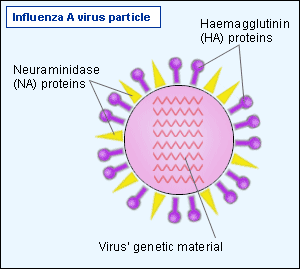What is swine flu?
Swine influenza, known as swine flu, influenza A (H1N1) or pandemic (H1N1) influenza 2009, is a respiratory disease of pigs caused by type A influenza viruses, most commonly the H1N1 subtype. Regular outbreaks of swine flu occur in pigs year round, and cases have been transmitted to humans. Previously, human-to-human transmission of swine influenza has been limited.
| How do new swine flu viruses arise? |
|---|
| Pigs can be hosts for several different flu viruses – swine influenza, avian (bird) influenza and human influenza. Sometimes more than one type of influenza virus can be present in a pig at the same time and this can allow genetic material from different virus types to mix, creating a new flu virus. Pigs have been known to be a potential source of new human flu viruses for a long time. The April 2009 outbreak of swine flu was caused by a new virus which had a mix of genes from human, avian and swine influenza viruses. These emerging new types of influenza virus make it difficult to create useful vaccines against them. |
What was special about the 2009 swine flu outbreak?
The April 2009 outbreak of swine influenza was of the H1N1 subtype and was shown to be transmitted between humans. The subtype of an influenza A virus (e.g. H1N1) is determined by the form of the haemagglutinin protein (e.g. H1) and the form of the neuraminidase protein (e.g. N1, N5) the virus carries.

Authorities (rightly) feared that this H1N1 subtype had features that would allow it to be easily passed from human to human and to cause a pandemic. Because the virus was so new, people did not generally have any immunity to it. Normally, flu viruses share some common features with the flu viruses of previous years – and so people may have a degree of resistance to them. But this new virus was different from those going before it, and so health authorities feared that people did not have any resistance to it – which gave it the potential to cause widespread infection.
The outbreak caused many deaths in Mexico, then spread to other countries. In June 2009 the World Health Organization declared that the world was at the start of the 2009 influenza pandemic.
During 2009 there were over 37,500 confirmed cases of swine flu in Australia, with 191 associated deaths.
In August 2010, the World Health Organization declared that swine flu had entered the post-pandemic period. Many people worldwide now have some immunity to pandemic (H1N1) influenza 2009 virus. However, the virus is expected to continue to circulate as a seasonal influenza strain for years, and many people are still susceptible to infection. The pandemic (H1N1) influenza 2009 virus continues to pose a higher risk for severe illness in certain people, including pregnant women, young children and those with chronic health problems.
| What is a pandemic? |
|---|
| A pandemic is an epidemic of disease that affects a wide geographic area. A famous pandemic was the Spanish flu pandemic of 1918. This was also caused by an influenza virus subtype H1N1, which spread to many parts of the world infecting an estimated half the world’s population at the time, and killing millions of people. |
What are the symptoms of swine flu?
The symptoms of swine flu are very similar to those of the human flu that we are familiar with each winter. These swine flu symptoms include: fever; cough; body aches and pains; fatigue; chills; headache; runny nose; sore throat; and respiratory distress (trouble breathing). Some people have reported diarrhoea and vomiting in association with swine flu.
What should I do if I think I have swine flu or have been in contact with someone who has swine flu?
Generally, pandemic H1N1 influenza is mild. Most people will be able to care for themselves at home and will not need to see a doctor. However, if you have flu-like symptoms and they are becoming worse, you should seek medical advice. Treatment is available but it needs to be given early in the disease. It is especially important to get medical advice at the first signs of severe illness in pregnant women, children, and in people who have chronic medical conditions.
Are there any treatments for swine flu?
There are antiviral medicines which are used to treat influenza. Two of these are available in Australia as Relenza (zanamivir) and Tamiflu (oseltamivir). They are available only on prescription from a doctor.
Using antiviral medicines soon after a person is infected with flu viruses (ideally within 2 days), can inhibit the flu viruses from multiplying in a person’s body and so make the illness less severe and make the person less likely to develop serious complications.
Is there a swine flu vaccine?
Yes. The 2011 seasonal influenza vaccine protects against 3 strains of flu virus, one of which is pandemic (H1N1) influenza 2009 virus (swine flu). This influenza vaccine does not contain live virus and so cannot give you influenza.
Panvax H1N1, the free vaccine developed against pandemic (H1N1) influenza 2009, was available until 31 December 2010 (when available stocks reached their expiry date). This separate vaccine is no longer available.
Related
ncG1vNJzZmilqZm%2Fb6%2FOpmWarV%2BnsrS8yKuYraeirnqpscClq6Fno6y2r7GMn6OuZZmjs63BxKexmmWRYrVyupBo